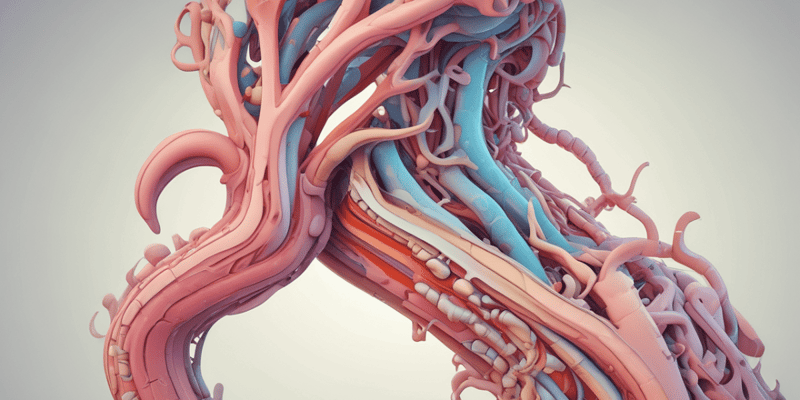Podcast
Questions and Answers
What is the main function of the mouth in the gastrointestinal tract?
What is the main function of the mouth in the gastrointestinal tract?
What does hydrolysis refer to in the context of digestion?
What does hydrolysis refer to in the context of digestion?
What is formed after the food is chewed and mixed with enzymes in the mouth?
What is formed after the food is chewed and mixed with enzymes in the mouth?
Which part of the gastrointestinal tract propels the bolus after it is swallowed?
Which part of the gastrointestinal tract propels the bolus after it is swallowed?
Signup and view all the answers
What is the overall function of the gastrointestinal tract described in the video?
What is the overall function of the gastrointestinal tract described in the video?
Signup and view all the answers
What happens to food during the process of chewing?
What happens to food during the process of chewing?
Signup and view all the answers
Which statement accurately describes the gastrointestinal tract?
Which statement accurately describes the gastrointestinal tract?
Signup and view all the answers
What is primarily the role of the esophagus in the digestive process?
What is primarily the role of the esophagus in the digestive process?
Signup and view all the answers
What is the primary function of the stomach in the gastrointestinal tract?
What is the primary function of the stomach in the gastrointestinal tract?
Signup and view all the answers
What is chyme?
What is chyme?
Signup and view all the answers
What process occurs in the small intestine?
What process occurs in the small intestine?
Signup and view all the answers
Which component of the gastrointestinal tract is primarily responsible for water and ion absorption?
Which component of the gastrointestinal tract is primarily responsible for water and ion absorption?
Signup and view all the answers
What is the role of the rectum in the gastrointestinal tract?
What is the role of the rectum in the gastrointestinal tract?
Signup and view all the answers
What occurs after food leaves the stomach?
What occurs after food leaves the stomach?
Signup and view all the answers
Which of the following is NOT a primary function of the stomach?
Which of the following is NOT a primary function of the stomach?
Signup and view all the answers
What is the main purpose of hydrolysis in the gastrointestinal tract?
What is the main purpose of hydrolysis in the gastrointestinal tract?
Signup and view all the answers
Which part of the gastrointestinal tract is described as 'boring' due to its limited functions?
Which part of the gastrointestinal tract is described as 'boring' due to its limited functions?
Signup and view all the answers
What accessory organs contribute to the digestion process?
What accessory organs contribute to the digestion process?
Signup and view all the answers
Study Notes
Overview of the Gastrointestinal Tract
- The gastrointestinal (GI) tract processes food from ingestion to expulsion, involving parts that do not actually belong to the body.
Mouth (Oral Cavity)
- Initial site for food entry, where chewing occurs (physical breakdown).
- Hydrolysis, enzymatic digestion, aids in breaking down food.
- Forms a bolus, a sphere of digested food, for swallowing.
Esophagus
- Connects mouth to stomach; its primary role is to propel the bolus without further processing.
Stomach
- Responsible for churning food, creating a mixture through multidimensional contractions.
- Continues hydrolysis to further break down food.
- Can store food before passing it to the intestines.
- Transforms bolus into chyme, a more fluid substance for digestion.
Small Intestine
- Comprised of three parts, beginning with the duodenum.
- Major site for hydrolysis and nutrient absorption, marking the first instance of harnessing nutrients from the digested food.
Large Intestine (Colon)
- Boring part of the GI tract; mainly absorbs water, ions, and vitamin K rather than nutrients.
- Not a significant source for acquiring nutrients.
Rectum
- Serves as a storage site for processed food until elimination is deemed appropriate.
- Expels waste through the anus.
Accessory Organs
- Involved in digestion but not as part of the GI tract. Includes the liver, gallbladder, and pancreas; covered in subsequent discussions.
Studying That Suits You
Use AI to generate personalized quizzes and flashcards to suit your learning preferences.
Description
This quiz explores the key components and functions of the gastrointestinal (GI) tract, starting from the mouth and continuing through to the esophagus. Learn about the initial stages of food processing, including chewing and enzymatic digestion, as well as the role of the esophagus in food transport. Test your knowledge of how these elements contribute to digestion.




